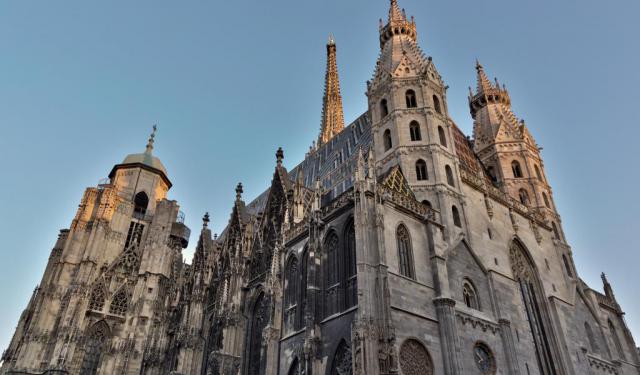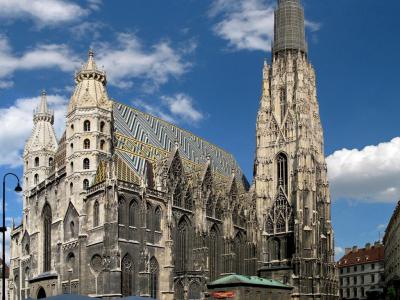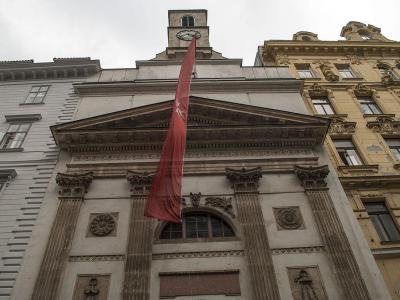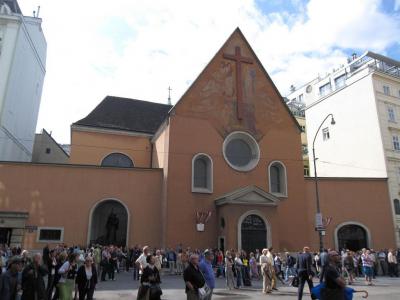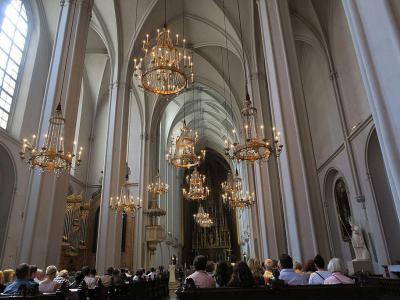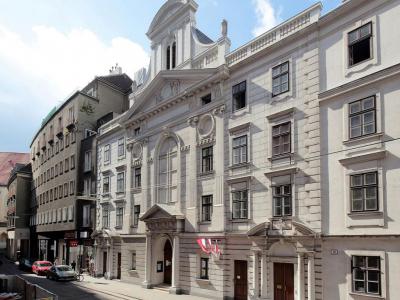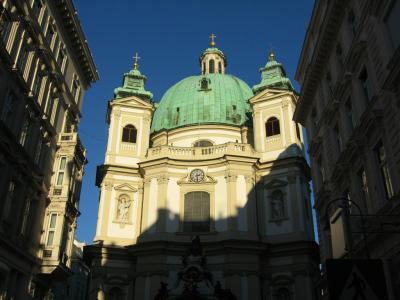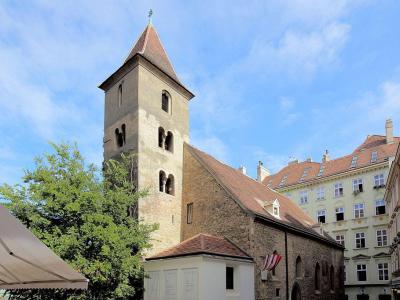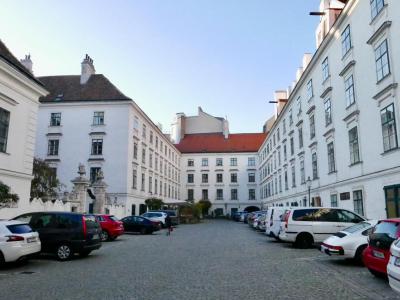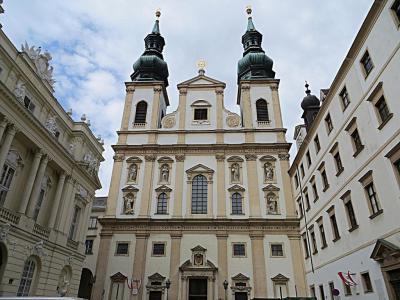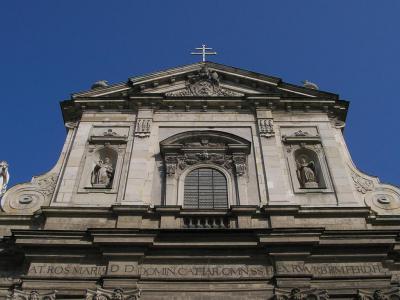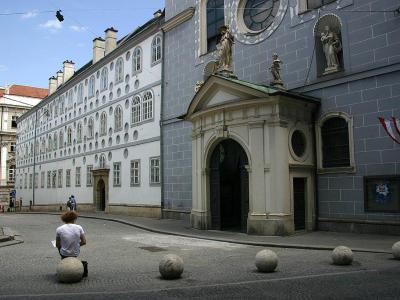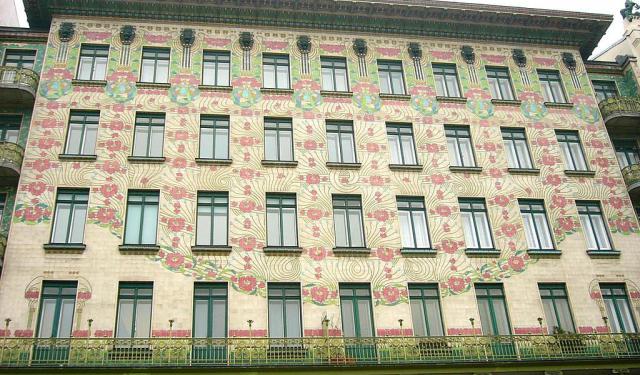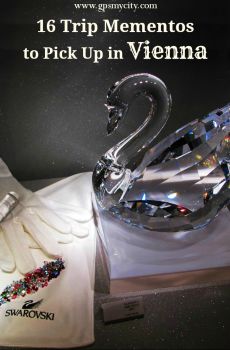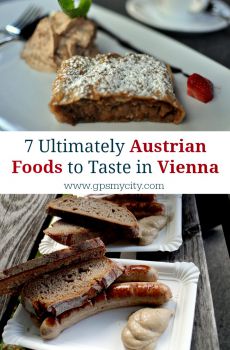Old Town Churches Walking Tour (Self Guided), Vienna
"Vienna is the city of miracles and music" – Whoever said that must have emphasized Vienna's close association with the Christian faith. The intertwining of Christian heritage and artistry in the Austrian capital finds expression primarily in its magnificent churches.
Sitting at "the crossroads of Christian traditions", Vienna is home to various Christian denominations: Catholic, Protestant, Eastern Orthodox, and others. The majority of local Christians are Catholics, which explains the strong influence of Roman Catholicism in the local architecture.
Indeed, the city is dotted with numerous Catholic churches and monasteries, many of which are true architectural marvels. The majestic Stephansdom (St Stephen's Cathedral), a Gothic masterpiece with its distinctive diamond-patterned roof tiles, is by far the main "jewel of Vienna's skyline". Located nearby is another masterpiece – of Baroque style – the charming Peterskirche (St Peter's Church), whose ornate interiors are said to be able to "transport you to another era".
Protestant denominations, including Lutheranism, presented in the form of the Lutherische Stadtkirche Wien (Lutheran City Church), also have a significant presence in Vienna.
These and other sanctuaries of art and spirituality, "where beauty meets devotion," never fail to impress visitors with their historic appeal and magnificent looks. A visit to Vienna is incomplete without marveling at the grandeur of local churches. To capture the spirit of the city's Christian tradition and, perhaps, experience the awe and reverence associated with its temples, you may wish to take this self-guided voyage.
Sitting at "the crossroads of Christian traditions", Vienna is home to various Christian denominations: Catholic, Protestant, Eastern Orthodox, and others. The majority of local Christians are Catholics, which explains the strong influence of Roman Catholicism in the local architecture.
Indeed, the city is dotted with numerous Catholic churches and monasteries, many of which are true architectural marvels. The majestic Stephansdom (St Stephen's Cathedral), a Gothic masterpiece with its distinctive diamond-patterned roof tiles, is by far the main "jewel of Vienna's skyline". Located nearby is another masterpiece – of Baroque style – the charming Peterskirche (St Peter's Church), whose ornate interiors are said to be able to "transport you to another era".
Protestant denominations, including Lutheranism, presented in the form of the Lutherische Stadtkirche Wien (Lutheran City Church), also have a significant presence in Vienna.
These and other sanctuaries of art and spirituality, "where beauty meets devotion," never fail to impress visitors with their historic appeal and magnificent looks. A visit to Vienna is incomplete without marveling at the grandeur of local churches. To capture the spirit of the city's Christian tradition and, perhaps, experience the awe and reverence associated with its temples, you may wish to take this self-guided voyage.
How it works: Download the app "GPSmyCity: Walks in 1K+ Cities" from Apple App Store or Google Play Store to your mobile phone or tablet. The app turns your mobile device into a personal tour guide and its built-in GPS navigation functions guide you from one tour stop to next. The app works offline, so no data plan is needed when traveling abroad.
Old Town Churches Walking Tour Map
Guide Name: Old Town Churches Walking Tour
Guide Location: Austria » Vienna (See other walking tours in Vienna)
Guide Type: Self-guided Walking Tour (Sightseeing)
# of Attractions: 13
Tour Duration: 2 Hour(s)
Travel Distance: 3.9 Km or 2.4 Miles
Author: leticia
Sight(s) Featured in This Guide:
Guide Location: Austria » Vienna (See other walking tours in Vienna)
Guide Type: Self-guided Walking Tour (Sightseeing)
# of Attractions: 13
Tour Duration: 2 Hour(s)
Travel Distance: 3.9 Km or 2.4 Miles
Author: leticia
Sight(s) Featured in This Guide:
- Stephansdom (St. Stephen's Cathedral)
- Malteserkirche (Maltese Church)
- Kapuzinerkirche (Capuchin Church)
- Augustinerkirche (Augustinian Church)
- Lutherische Stadtkirche Wien (Lutheran City Church)
- Michaelerkirche (St. Michael's Church)
- Peterskirche (St. Peter's Church)
- Maria am Gestade (Mary at the Shore)
- Ruprechtskirche (Church of St. Rupert)
- Heiligenkreuzerhof
- Jesuitenkirche (Jesuit Church)
- Dominikanerkirche (Dominican Church)
- Franziskanerkirche (Franciscan Church)
1) Stephansdom (St. Stephen's Cathedral) (must see)
In a city where “stunning architecture” is practically the dress code, Saint Stephen’s Cathedral still manages to steal the spotlight-and possibly your neck muscles too, as you crane to admire that towering spire. Known locally as Stephansdom, this Gothic-Romanesque powerhouse has stood at the heart of Vienna’s skyline and soul since 1147, rising on the bones of two earlier churches like the overachiever it is.
In the 14th century, Duke Rudolf IV decided the cathedral needed a serious makeover. The idea worked. As a result, today we have the building stretching 107 meters long, 40 meters wide, and topped by the South Tower-or “Steffl,” if you're on nickname terms-a 136-meter-high feat of medieval determination that took 65 years to complete. It even moonlighted as a lookout post during Vienna’s sieges, complete with a live-in watchman until 1955. One heck of a long shift...
Meanwhile, the North Tower never quite hit its growth spurt. It stalled at 68 meters and got a Renaissance hat in 1578-basically the architectural equivalent of saying “this is fine” and walking away.
But the real showstopper here is the roof. A kaleidoscope of 230,000 glazed tiles arranged into imperial emblems like the double-headed eagle of the Habsburgs and the crests of Vienna and Austria. After being torched in World War II, it was rebuilt with steel instead of wood-600 metric tons of it-making the new roof not just durable, but also self-cleaning. Because even cathedrals love low-maintenance routines...
Inside, things get just as grand. There’s Pummerin, Europe’s second-largest swinging bell, forged from Turkish cannons in 1711 and recast in 1951-because nothing says peace like a bell made from wartime leftovers. Oh, and she lives in the North Tower, ringing out for special moments and daily rituals.
Musical legends haunt these hallowed halls too: Beethoven figured out he was deaf here (tragic), Haydn sang here as a kid (sweet), Strauss got married here-twice (bold), and Mozart? He got married and buried here. Yes, Saint Stephen's is basically the VIP lounge of Viennese music history.
Inside, you’ll find 18 altars, miraculous icons, bone relics-including those of Saint Valentine-and a maze of crypts holding 11,000 souls, including Habsburg royalty.
Tip:
Do a lap around the outside. Gargoyles, engravings, medieval graffiti-you never know what stories the stones will whisper...
In the 14th century, Duke Rudolf IV decided the cathedral needed a serious makeover. The idea worked. As a result, today we have the building stretching 107 meters long, 40 meters wide, and topped by the South Tower-or “Steffl,” if you're on nickname terms-a 136-meter-high feat of medieval determination that took 65 years to complete. It even moonlighted as a lookout post during Vienna’s sieges, complete with a live-in watchman until 1955. One heck of a long shift...
Meanwhile, the North Tower never quite hit its growth spurt. It stalled at 68 meters and got a Renaissance hat in 1578-basically the architectural equivalent of saying “this is fine” and walking away.
But the real showstopper here is the roof. A kaleidoscope of 230,000 glazed tiles arranged into imperial emblems like the double-headed eagle of the Habsburgs and the crests of Vienna and Austria. After being torched in World War II, it was rebuilt with steel instead of wood-600 metric tons of it-making the new roof not just durable, but also self-cleaning. Because even cathedrals love low-maintenance routines...
Inside, things get just as grand. There’s Pummerin, Europe’s second-largest swinging bell, forged from Turkish cannons in 1711 and recast in 1951-because nothing says peace like a bell made from wartime leftovers. Oh, and she lives in the North Tower, ringing out for special moments and daily rituals.
Musical legends haunt these hallowed halls too: Beethoven figured out he was deaf here (tragic), Haydn sang here as a kid (sweet), Strauss got married here-twice (bold), and Mozart? He got married and buried here. Yes, Saint Stephen's is basically the VIP lounge of Viennese music history.
Inside, you’ll find 18 altars, miraculous icons, bone relics-including those of Saint Valentine-and a maze of crypts holding 11,000 souls, including Habsburg royalty.
Tip:
Do a lap around the outside. Gargoyles, engravings, medieval graffiti-you never know what stories the stones will whisper...
2) Malteserkirche (Maltese Church)
The Maltese Church, also known as the Malteserkirche, is a Gothic church located on Kärntner Straße in Vienna. It has historical ties to the Knights Hospitaller. The earliest reference to a church at this location dates back to 1217 when it was referred to as a "House of the Prueder of the Order of Saint John." This establishment served as a commandry to provide care and support for crusaders.
The existing church building was constructed during the mid-15th century. In the 17th century, it gained popularity as a favored preaching location for Abraham a Sancta Clara.
During the Baroque era, the church underwent renovations to align with contemporary architectural preferences. Further alterations took place in 1806. In the 19th century, stained glass windows were added to the Kommendenhaus in 1839 and various parts of the church in 1857.
Following financial difficulties faced by the Order after the First World War, the church had to be sold in 1933, along with the Johanneshof. Subsequently, the church was repurposed while maintaining its historical significance through preservation orders. In 1960, it was reacquired and underwent a phased restoration process, culminating in a comprehensive restoration in 1998.
One notable feature of the church is its high altarpiece, which was painted by Johann Georg Schmidt in 1730.
The existing church building was constructed during the mid-15th century. In the 17th century, it gained popularity as a favored preaching location for Abraham a Sancta Clara.
During the Baroque era, the church underwent renovations to align with contemporary architectural preferences. Further alterations took place in 1806. In the 19th century, stained glass windows were added to the Kommendenhaus in 1839 and various parts of the church in 1857.
Following financial difficulties faced by the Order after the First World War, the church had to be sold in 1933, along with the Johanneshof. Subsequently, the church was repurposed while maintaining its historical significance through preservation orders. In 1960, it was reacquired and underwent a phased restoration process, culminating in a comprehensive restoration in 1998.
One notable feature of the church is its high altarpiece, which was painted by Johann Georg Schmidt in 1730.
3) Kapuzinerkirche (Capuchin Church)
The Kapuzinerkirche, commonly known as the Capuchin Church, serves as both a religious site and a monastery for the Order of Friars Minor Capuchin. Its construction commenced in the early 17th century, yet it faced a halt due to the disruptions caused by the 30 Years War. Eventually completed in 1632, this church is renowned for housing a series of tombs beneath its structure, most notably those belonging to members of the Habsburg dynasty. Notably, Otto von Habsburg, the last Habsburg to be laid to rest here, passed away in July 2011.
This church possesses a unique architectural feature, lacking aisles, which adds to its overall charm through its simplicity. Although the majority of tourists visit primarily to explore the Imperial Crypt, it's essential to recognize the historical significance of the church itself. It has endured the test of time, with minimal damage incurred from wars and other political upheavals.
The Imperial Crypt serves as the final resting place for 18 Empresses and 12 Emperors, with approximately 120 other aristocrats also finding their eternal abode here. Some of the tombs are particularly opulent, especially those dedicated to the parents of Marie Antoinette. Guided tours are available to allow visitors to explore both the church and the crypt. Moreover, the church hosts the extraordinary form of the Roman rite daily. While it may not be the most extravagant church in Vienna, it is an absolute must-visit for anyone with an interest in history.
This church possesses a unique architectural feature, lacking aisles, which adds to its overall charm through its simplicity. Although the majority of tourists visit primarily to explore the Imperial Crypt, it's essential to recognize the historical significance of the church itself. It has endured the test of time, with minimal damage incurred from wars and other political upheavals.
The Imperial Crypt serves as the final resting place for 18 Empresses and 12 Emperors, with approximately 120 other aristocrats also finding their eternal abode here. Some of the tombs are particularly opulent, especially those dedicated to the parents of Marie Antoinette. Guided tours are available to allow visitors to explore both the church and the crypt. Moreover, the church hosts the extraordinary form of the Roman rite daily. While it may not be the most extravagant church in Vienna, it is an absolute must-visit for anyone with an interest in history.
4) Augustinerkirche (Augustinian Church)
The Augustinerkirche, also known as the Augustinian Church, was originally constructed to serve the royal court of the Habsburg dynasty. It was built in 1339, initially situated within the palace grounds. Over time, as the palace expanded, the church became integrated into the Hofburg complex. Notably, the church boasts an exquisite steeple that distinguishes it from the rest of the Hofburg.
This church also includes a cloister intended for Augustinian friars. Presently, it is tended to by six monks who cater to the spiritual needs of the local congregation. Throughout its history, this church has been the venue for numerous royal events, including the marriage of Archduchess Marie-Louise to Napoleon Bonaparte in 1810. Interestingly, Napoleon himself did not attend the wedding, and it was conducted by proxy.
Upon entering the Gothic church, one is immediately struck by its austere yet captivating beauty. It features tall, slender windows and magnificent chandeliers. Of particular note is the cenotaph dedicated to Maria Christina of Austria, located near the rear entrance. This poignant memorial, sculpted in 1805, portrays the entire family entering a temple.
The church also houses several chapels, with two of them open to visitors on a limited basis. The Loreto chapel is notable for its collection of 54 silver urns containing the hearts of departed Habsburg rulers, which can be glimpsed through a windowed door. The physical remains of these rulers are entombed in the Kapuzinerkirche.
For those interested in visiting these chapels, the optimal time is after the Sunday mass. During the summer, the mass includes awe-inspiring organ music that resonates beautifully within this setting. It's advisable to arrive no later than 10:15 to secure a seat for the 11 am mass, as it tends to be very popular.
This church also includes a cloister intended for Augustinian friars. Presently, it is tended to by six monks who cater to the spiritual needs of the local congregation. Throughout its history, this church has been the venue for numerous royal events, including the marriage of Archduchess Marie-Louise to Napoleon Bonaparte in 1810. Interestingly, Napoleon himself did not attend the wedding, and it was conducted by proxy.
Upon entering the Gothic church, one is immediately struck by its austere yet captivating beauty. It features tall, slender windows and magnificent chandeliers. Of particular note is the cenotaph dedicated to Maria Christina of Austria, located near the rear entrance. This poignant memorial, sculpted in 1805, portrays the entire family entering a temple.
The church also houses several chapels, with two of them open to visitors on a limited basis. The Loreto chapel is notable for its collection of 54 silver urns containing the hearts of departed Habsburg rulers, which can be glimpsed through a windowed door. The physical remains of these rulers are entombed in the Kapuzinerkirche.
For those interested in visiting these chapels, the optimal time is after the Sunday mass. During the summer, the mass includes awe-inspiring organ music that resonates beautifully within this setting. It's advisable to arrive no later than 10:15 to secure a seat for the 11 am mass, as it tends to be very popular.
5) Lutherische Stadtkirche Wien (Lutheran City Church)
The Lutheran City Church, also known as Lutherische Stadtkirche Wien, has undergone significant transformations since its initial construction in 1582. Back then, it served as a Catholic monastery commissioned by Elisabeth of Austria. Following her widowhood, she resided in this monastery, and there is speculation that the church was constructed as an act of penance, possibly in response to the Saint Bartholomew's Day massacre.
During the religious turbulence of the 18th century, the church was abandoned. In 1783 the monastery was purchased and divided among the three new owners, the Lutheran Church, the Reformed Church and a private investor who used his portion to build a palace. At this time in Vienna’s history, Protestant churches were not allowed to have steeples or any exterior adornments that would denote that a church was there. The building was significantly altered during this time.
In 1876 the winds of religious fortunes again changed and Protestant churches could now look like a church. Significant modifications were again made to the building. WWII bombing caused significant damage to the Church and the building was again rebuilt with a new face. The latest renovations to the building occurred in the late 1980s with a return to the 1907 look.
Several features have survived all the remodeling and damage. Christ on the Cross is a copy of the van Dyke painting that is the altar piece. There are also marble plates that are relics from when the hearts of several leaders were buried here. The church has no aisles which makes it rather unique too. Located at Dorotheergasse 18, there are also other churches and sights to see within just a short walk.
During the religious turbulence of the 18th century, the church was abandoned. In 1783 the monastery was purchased and divided among the three new owners, the Lutheran Church, the Reformed Church and a private investor who used his portion to build a palace. At this time in Vienna’s history, Protestant churches were not allowed to have steeples or any exterior adornments that would denote that a church was there. The building was significantly altered during this time.
In 1876 the winds of religious fortunes again changed and Protestant churches could now look like a church. Significant modifications were again made to the building. WWII bombing caused significant damage to the Church and the building was again rebuilt with a new face. The latest renovations to the building occurred in the late 1980s with a return to the 1907 look.
Several features have survived all the remodeling and damage. Christ on the Cross is a copy of the van Dyke painting that is the altar piece. There are also marble plates that are relics from when the hearts of several leaders were buried here. The church has no aisles which makes it rather unique too. Located at Dorotheergasse 18, there are also other churches and sights to see within just a short walk.
6) Michaelerkirche (St. Michael's Church)
The oldest building on Michaelerplatz, and the source of its name, Michaelerkirche was first built in the 13th century, though the Neoclassical facade, added in 1792, somewhat obscures this fact. The high polygonal Gothic bell tower from the 16th century may be seen from far away, having become one of the Inner City's symbols. Above the entrance, on top of the pediment, resting on Doric columns, stands a group with winged angels and Saint Michael slaying Lucifer (1725). These sculptural figures were executed by the Italian sculptor Lorenzo Mattielli, who also sculpted the Hercules figures at the Hofburg entrance, just opposite the church.
Inside, the church retains its plain Gothic origins, but sculptor sculptor Karl Georg Merville's "Fall of Angels" steals the show: a monumental stucco alabaster Rococo sculpture, tumbling from the ceiling above the high altar. The gilded pipe organ (1714) – Vienna's largest Baroque organ – is very fine; it was once played by the 17-year-old Joseph Haydn, who lived next door in a small attic room. The very first playing of Mozart's unfinished "Requiem" first took place here on December 10, 1791, in a requiem service for the composer. Just to the right of the church's entrance, you will find two dark reliefs commemorating said performance.
Off the north choir is the entrance to a huge crypt, discovered by U.S. soldiers in 1945, when they forced open its doors, which had been sealed for 150 years. Found lying undisturbed for centuries were hundreds of mummified former wealthy parishioners, clothed in their burial finery that was perfectly preserved by the rarefied air within.
Inside, the church retains its plain Gothic origins, but sculptor sculptor Karl Georg Merville's "Fall of Angels" steals the show: a monumental stucco alabaster Rococo sculpture, tumbling from the ceiling above the high altar. The gilded pipe organ (1714) – Vienna's largest Baroque organ – is very fine; it was once played by the 17-year-old Joseph Haydn, who lived next door in a small attic room. The very first playing of Mozart's unfinished "Requiem" first took place here on December 10, 1791, in a requiem service for the composer. Just to the right of the church's entrance, you will find two dark reliefs commemorating said performance.
Off the north choir is the entrance to a huge crypt, discovered by U.S. soldiers in 1945, when they forced open its doors, which had been sealed for 150 years. Found lying undisturbed for centuries were hundreds of mummified former wealthy parishioners, clothed in their burial finery that was perfectly preserved by the rarefied air within.
7) Peterskirche (St. Peter's Church) (must see)
Tucked snugly among Vienna’s Baroque showpieces like a pearl in a pastry, Saint Peter’s Church has a front-row seat to history, and not much else, thanks to the buildings crowding around it. You’ll mostly catch it head-on, which, honestly, is its best angle.
This spot has seen churches come and go like emperors with changing tastes. Some say the very first church here dates back to the early 4th century AD, making it one of the oldest in Vienna-yes, back when sandals were in and Rome was still a big deal. In 792, none other than King Charlemagne is said to have popped by and said, “Let’s build.” There’s even a plaque on the façade bragging about it. Historical records, ever the skeptics, first mention the church in 1137, but who’s counting?
By the late 1100s, the church cozied up to the newly founded Schottenstift monastery. Then came fire, plague, and drama. After the 1661 fire, it got a bit of a patch job… until the plague of 1679 cleared the streets and cleared the way for Emperor Leopold I, who swore a divine vow to rebuild. And he did...
Construction began around 1701, drawing heavy inspiration from Saint Peter’s Basilica in Rome-because if you’re going to imitate, imitate the best. By 1733, Vienna had its first domed Baroque beauty, cleverly built with a compact, oval layout to fit the tight space.
Outside, it sports a neat combo of white and barely-there yellow, flanked by two towers that curve ever so slightly inward-apparently a cheeky nod to Turkish tent poles from the 1683 siege.
Step inside, and there you have it: gold stucco, opulent frescoes, and Johann Michael Rottmayr’s artistic fireworks overhead, including the Coronation of Our Lady. The high altar gets dramatic with a healing scene, starring Saint Peter and Saint John, and around the edges, you'll spot relics of Roman martyrs, reclining in crystal coffins like glittering saints on display.
The church was polished up in a major 1998–2004 renovation, and today it’s still a Baroque gem in Vienna’s crown.
Hot tip:
Drop in any day from 3 to 3:30 pm for a free organ concert-divine music, no ticket required (but donations are saintly). And if you're lucky, catch a choir in the crypts. Now that’s a holy experience...
This spot has seen churches come and go like emperors with changing tastes. Some say the very first church here dates back to the early 4th century AD, making it one of the oldest in Vienna-yes, back when sandals were in and Rome was still a big deal. In 792, none other than King Charlemagne is said to have popped by and said, “Let’s build.” There’s even a plaque on the façade bragging about it. Historical records, ever the skeptics, first mention the church in 1137, but who’s counting?
By the late 1100s, the church cozied up to the newly founded Schottenstift monastery. Then came fire, plague, and drama. After the 1661 fire, it got a bit of a patch job… until the plague of 1679 cleared the streets and cleared the way for Emperor Leopold I, who swore a divine vow to rebuild. And he did...
Construction began around 1701, drawing heavy inspiration from Saint Peter’s Basilica in Rome-because if you’re going to imitate, imitate the best. By 1733, Vienna had its first domed Baroque beauty, cleverly built with a compact, oval layout to fit the tight space.
Outside, it sports a neat combo of white and barely-there yellow, flanked by two towers that curve ever so slightly inward-apparently a cheeky nod to Turkish tent poles from the 1683 siege.
Step inside, and there you have it: gold stucco, opulent frescoes, and Johann Michael Rottmayr’s artistic fireworks overhead, including the Coronation of Our Lady. The high altar gets dramatic with a healing scene, starring Saint Peter and Saint John, and around the edges, you'll spot relics of Roman martyrs, reclining in crystal coffins like glittering saints on display.
The church was polished up in a major 1998–2004 renovation, and today it’s still a Baroque gem in Vienna’s crown.
Hot tip:
Drop in any day from 3 to 3:30 pm for a free organ concert-divine music, no ticket required (but donations are saintly). And if you're lucky, catch a choir in the crypts. Now that’s a holy experience...
8) Maria am Gestade (Mary at the Shore)
Maria am Gestade (Mary at the Shore) stands as a venerable Gothic church within Vienna. It ranks among the city's oldest religious edifices, sharing this distinction with Saint Peter's Church and Saint Rupert's Church. Additionally, it represents a rare surviving specimen of Gothic architectural style. Situated in Vienna's Innere Stadt, specifically at Salvatorgasse 12, in proximity to the Donaukanal, this church traditionally served the needs of Danube river sailors. Its name harkens back to its original location on the Fluvial terrace of a Danube river branch prior to regulation efforts.
The church's most prominent feature is its towering open-work structure, rising to a height of 56 meters (about 180 feet). This Gothic marvel was constructed between 1419 and 1428, featuring intricate scroll-work. Its distinct appearance can be discerned from afar and is depicted in the earliest depictions of the city. The choir, whose construction commenced in 1330, contains two splendid examples of high Gothic panels. The church's medieval stained glass windows remain, with the nave's narrower design influenced by the Danube's course. Construction began in 1400, attributed to Duke Albrecht III.
Maria am Gestade boasts three porticoes adorned with reliefs and sculptures. The choir door exhibits depictions of the Virgin of Mercy and the Coronation of the Virgin, both dating back to around 1350. These can be observed on the Middle Portal, which features realistic representations of angels playing musical instruments. The main portal on the west facade features canopies with reliefs of Saint Johns (Baptist and Evangelist) from around 1410, reminiscent of Prague's Saint Vitus Cathedral. Additionally, the church has 20th-century sculptures and mosaic decorations.
The church's most prominent feature is its towering open-work structure, rising to a height of 56 meters (about 180 feet). This Gothic marvel was constructed between 1419 and 1428, featuring intricate scroll-work. Its distinct appearance can be discerned from afar and is depicted in the earliest depictions of the city. The choir, whose construction commenced in 1330, contains two splendid examples of high Gothic panels. The church's medieval stained glass windows remain, with the nave's narrower design influenced by the Danube's course. Construction began in 1400, attributed to Duke Albrecht III.
Maria am Gestade boasts three porticoes adorned with reliefs and sculptures. The choir door exhibits depictions of the Virgin of Mercy and the Coronation of the Virgin, both dating back to around 1350. These can be observed on the Middle Portal, which features realistic representations of angels playing musical instruments. The main portal on the west facade features canopies with reliefs of Saint Johns (Baptist and Evangelist) from around 1410, reminiscent of Prague's Saint Vitus Cathedral. Additionally, the church has 20th-century sculptures and mosaic decorations.
9) Ruprechtskirche (Church of St. Rupert)
Ruprechtskirche, also known as the Church of Saint Rupert, is believed to hold the distinction of being the oldest church in Vienna. While some recent debates have arisen challenging this claim, it is noteworthy for housing Vienna's most ancient stained glass window and the oldest set of bells. The church is dedicated to Saint Rupert of Salzburg, who is the patron saint of salt merchants in Vienna.
Traditionally, the church's origins date back to the early 8th century, though even this timeline has faced disputes. The earliest written mention of the church can be traced to around 1200, and in this document, it is described as Vienna's oldest church. Over the centuries, Ruprechtskirche has had a fascinating history, serving as a hub for the salt trade and even functioning as a place of confinement for prisoners.
The church has undergone several renovations, particularly following a devastating fire in 1276, during which the oldest surviving stained glass window was likely added. This window depicts the Madonna and Child alongside the Crucified Christ. As recently as the late 1990s, modifications and restorations have been carried out.
Ruprechtskirche is open to the public, welcoming visitors to explore its beautiful and historic sanctuary. While regular religious services are not held here, the venue hosts various events. Visitors are encouraged to enter, take a moment for reflection, wander through its corridors, and appreciate this valuable piece of history.
Why You Should Visit:
The stained-glass windows are stunning and the simplicity is a change from the baroque seen elsewhere.
Tip:
Don't miss the 'Alte Musik in Ruprecht' concerts that the church offers, featuring music from the Medieval to early Romantic periods played on original instruments by world-class artists.
Traditionally, the church's origins date back to the early 8th century, though even this timeline has faced disputes. The earliest written mention of the church can be traced to around 1200, and in this document, it is described as Vienna's oldest church. Over the centuries, Ruprechtskirche has had a fascinating history, serving as a hub for the salt trade and even functioning as a place of confinement for prisoners.
The church has undergone several renovations, particularly following a devastating fire in 1276, during which the oldest surviving stained glass window was likely added. This window depicts the Madonna and Child alongside the Crucified Christ. As recently as the late 1990s, modifications and restorations have been carried out.
Ruprechtskirche is open to the public, welcoming visitors to explore its beautiful and historic sanctuary. While regular religious services are not held here, the venue hosts various events. Visitors are encouraged to enter, take a moment for reflection, wander through its corridors, and appreciate this valuable piece of history.
Why You Should Visit:
The stained-glass windows are stunning and the simplicity is a change from the baroque seen elsewhere.
Tip:
Don't miss the 'Alte Musik in Ruprecht' concerts that the church offers, featuring music from the Medieval to early Romantic periods played on original instruments by world-class artists.
10) Heiligenkreuzerhof
The Heiligenkreuaerhof and Bernardikapelle is a collection of shops, apartment’s courtyards and one beautiful old church. This area may be a bit difficult to find, but it is worth the effort. This area was once home to merchants and the shops were outside of the protective city walls. Some of the basements date back to the 12th century although most of the visible parts of the buildings there now are considerably newer. The buildings were generally built in the mid 17th to mid 18th centuries.
Although the Bernadikapelle may be a bit understated from the outside, this little chapel is beautiful on the inside and is a very popular spot to have a wedding. The chapel is not open for public display, but tours are regularly given. Be sure to sign up for the tour as the chapel is an excellent example of Baroque furnishings at its best.
The area is sometimes called “Vienna’s oldest apartment block” and the name may make one disinclined to make the effort on a busy vacation to visit this spot. However, the small shops here and the lovely chapel will not disappoint. It may well be one of the highlights of any trip.
Although the Bernadikapelle may be a bit understated from the outside, this little chapel is beautiful on the inside and is a very popular spot to have a wedding. The chapel is not open for public display, but tours are regularly given. Be sure to sign up for the tour as the chapel is an excellent example of Baroque furnishings at its best.
The area is sometimes called “Vienna’s oldest apartment block” and the name may make one disinclined to make the effort on a busy vacation to visit this spot. However, the small shops here and the lovely chapel will not disappoint. It may well be one of the highlights of any trip.
11) Jesuitenkirche (Jesuit Church)
The Jesuit Church, known as Jesuitenkirche, stands proudly on Dr. Ignaz Seipel-Platz in Vienna. This architectural gem was completed back in 1627 and stands as a remarkable example of Baroque design, albeit with a few unique features. Initially, the twin towers might strike you as somewhat unusual, but the overall structure comes together harmoniously. The ornate niches adorned with statues on the building are simply exquisite. Originally, the church was dedicated to Saint Loyola and Saint Francis Xavier upon its construction. However, in 1703, it underwent a rededication ceremony in honor of the Assumption of Mary.
Stepping inside the Jesuitenkirche is a treat for the eyes and certainly worth a visit. Make sure not to miss the breathtaking trompe l’oeil dome painted on the barrel ceiling, skillfully designed to mimic a true dome. Emperor Leopold I commissioned this masterpiece, which was executed by the talented artist Andrea Pozzo, responsible for the frescoes throughout the building.
In the mid-1400s, Vienna played a significant role in European academia, but by the late 1500s, the area had seen a decline in student population due to ongoing conflicts. The university joined forces with the Jesuits in 1623, leading to the creation of this magnificent church. The history of the Jesuits in Austria has had its ups and downs, but their architectural legacy endures once more in this splendid structure.
Stepping inside the Jesuitenkirche is a treat for the eyes and certainly worth a visit. Make sure not to miss the breathtaking trompe l’oeil dome painted on the barrel ceiling, skillfully designed to mimic a true dome. Emperor Leopold I commissioned this masterpiece, which was executed by the talented artist Andrea Pozzo, responsible for the frescoes throughout the building.
In the mid-1400s, Vienna played a significant role in European academia, but by the late 1500s, the area had seen a decline in student population due to ongoing conflicts. The university joined forces with the Jesuits in 1623, leading to the creation of this magnificent church. The history of the Jesuits in Austria has had its ups and downs, but their architectural legacy endures once more in this splendid structure.
12) Dominikanerkirche (Dominican Church)
The Dominican Church, also known as the Church of Saint Maria Rotunda in German (Dominikanerkirche), stands as an early Baroque parish church and minor basilica located in Vienna, Austria's historic center. It's worth noting that this is the third church constructed on this very site over time.
The initial church was established in 1237 by the newly arrived Dominicans, following the land allocation in 1225-1226 by Duke Leopold VI. Between 1240 and 1270, the church underwent enlargement, including the addition of a new choir in 1273. Subsequently, a series of fires led to the construction of a new Gothic church between 1283 and 1302. Further expansion occurred between 1458 and 1474, resulting in a church with a nave consisting of five cross vaults and two aisles.
Unfortunately, the church endured significant damage during the first siege of Vienna by the Turkish army in 1529, resulting in the demolition of the choir and partial dismantling of the nave. Over the following years, the building gradually fell into disrepair.
Due to the Counter-Reformation's influence, a new church was built in Vienna in 1631, following a design by Jacopo Tencala. Master builders Spacio, Biasino, and Canevale introduced Italian Baroque style. Emperor Ferdinand II laid the first stone on May 29, 1631, and the church was consecrated on October 1, 1634, with final touches added in 1674. It became a minor basilica in 1927, known as "Rosary Basilica ad S. Mariam Rotundam."
The initial church was established in 1237 by the newly arrived Dominicans, following the land allocation in 1225-1226 by Duke Leopold VI. Between 1240 and 1270, the church underwent enlargement, including the addition of a new choir in 1273. Subsequently, a series of fires led to the construction of a new Gothic church between 1283 and 1302. Further expansion occurred between 1458 and 1474, resulting in a church with a nave consisting of five cross vaults and two aisles.
Unfortunately, the church endured significant damage during the first siege of Vienna by the Turkish army in 1529, resulting in the demolition of the choir and partial dismantling of the nave. Over the following years, the building gradually fell into disrepair.
Due to the Counter-Reformation's influence, a new church was built in Vienna in 1631, following a design by Jacopo Tencala. Master builders Spacio, Biasino, and Canevale introduced Italian Baroque style. Emperor Ferdinand II laid the first stone on May 29, 1631, and the church was consecrated on October 1, 1634, with final touches added in 1674. It became a minor basilica in 1927, known as "Rosary Basilica ad S. Mariam Rotundam."
13) Franziskanerkirche (Franciscan Church)
The Franziskanerkirche, also referred to as the Church of Saint Jerome or the Franciscan Church in Vienna, boasts an intriguing blend of architectural styles. The exterior of this splendid church showcases Renaissance design, while the interior is a splendid example of pure Baroque aesthetics. This unique combination makes it a captivating destination for visitors. Unlike many tourist-heavy areas, the church is located in a quieter locale, surrounded by charming small shops and cozy cafes that enhance the overall experience.
The current church was constructed in the early 1600s, replacing a previous church that had been demolished. Both places of worship were dedicated to Saint Hieronymus, and an interesting statue of him adorns the entrance, giving visitors a glimpse of the Baroque opulence that awaits inside.
Once inside, amid the opulent golden and marble decor, you'll find Vienna's oldest known organ, the Wöckherlorgel, dating back to around 1640. The church's magnificent high altar, crafted by an Italian artist during the same period, adds to its grandeur. Although the majority of the church's construction predates the late 18th century, the tomb of Father Peter Pavlicek is a more recent addition. Father Pavlicek, an Austrian Franciscan priest, organized a Rosary crusade following World War II, urging Austrians to daily recite the Rosary until the Russian occupation of the country ended. He passed away in 1982, and his final resting place can be found within the church.
The current church was constructed in the early 1600s, replacing a previous church that had been demolished. Both places of worship were dedicated to Saint Hieronymus, and an interesting statue of him adorns the entrance, giving visitors a glimpse of the Baroque opulence that awaits inside.
Once inside, amid the opulent golden and marble decor, you'll find Vienna's oldest known organ, the Wöckherlorgel, dating back to around 1640. The church's magnificent high altar, crafted by an Italian artist during the same period, adds to its grandeur. Although the majority of the church's construction predates the late 18th century, the tomb of Father Peter Pavlicek is a more recent addition. Father Pavlicek, an Austrian Franciscan priest, organized a Rosary crusade following World War II, urging Austrians to daily recite the Rosary until the Russian occupation of the country ended. He passed away in 1982, and his final resting place can be found within the church.
Walking Tours in Vienna, Austria
Create Your Own Walk in Vienna
Creating your own self-guided walk in Vienna is easy and fun. Choose the city attractions that you want to see and a walk route map will be created just for you. You can even set your hotel as the start point of the walk.
Vienna's Art Nouveau Architecture Tour II
If there are cities that flirt, Vienna is definitely the one. Here, even the buildings know how to do it.
Around the turn of the 20th century, the Austrian capital caught the Art Nouveau fever and decided that straight lines, drab walls, and historical imitation simply wouldn’t do anymore. Instead, it took to ornamental swirls, flowing curves, floral flourishes, and enough decorative detail... view more
Tour Duration: 1 Hour(s)
Travel Distance: 2.0 Km or 1.2 Miles
Around the turn of the 20th century, the Austrian capital caught the Art Nouveau fever and decided that straight lines, drab walls, and historical imitation simply wouldn’t do anymore. Instead, it took to ornamental swirls, flowing curves, floral flourishes, and enough decorative detail... view more
Tour Duration: 1 Hour(s)
Travel Distance: 2.0 Km or 1.2 Miles
Mozart Walking Tour
Wolfgang Amadeus Mozart spent a significant portion of his life in Vienna. Here, he achieved recognition, and the city holds enormous historical and cultural significance for his legacy. Mozart first visited Vienna as a child prodigy in 1762, and in 1781 came here to stay.
The city met the composer with a vibrant and cosmopolitan atmosphere brought about by some of the top musicians and artists... view more
Tour Duration: 1 Hour(s)
Travel Distance: 2.0 Km or 1.2 Miles
The city met the composer with a vibrant and cosmopolitan atmosphere brought about by some of the top musicians and artists... view more
Tour Duration: 1 Hour(s)
Travel Distance: 2.0 Km or 1.2 Miles
Vienna's Art Nouveau Architecture Tour I
Vienna’s flirtation with Art Nouveau-known locally as Jugendstil-unfolded in the late 19th, early 20th centuries. The so-called Vienna Secession movement, which emerged in 1897, was led by a group of rebellious artists and architects like Otto Wagner, Gustav Klimt, and Koloman Moser, who turned their backs on historicism in favor of bold, modern aesthetics. As the new language for buildings,... view more
Tour Duration: 2 Hour(s)
Travel Distance: 3.4 Km or 2.1 Miles
Tour Duration: 2 Hour(s)
Travel Distance: 3.4 Km or 2.1 Miles
Vienna's Historical Music Venues
Austria is synonymous with classical music almost to the point of obsession, and to call Vienna the "Musical Capital of the World" would be hardly an exaggeration. Indeed, over the past centuries, the city served as the home and workplace for many great musicians like Wolfgang Amadeus Mozart, Ludwig van Beethoven, Johann Strauss, Joseph Haydn, Franz Schubert, and others.
Among the... view more
Tour Duration: 2 Hour(s)
Travel Distance: 3.0 Km or 1.9 Miles
Among the... view more
Tour Duration: 2 Hour(s)
Travel Distance: 3.0 Km or 1.9 Miles
Vienna Introduction Walking Tour
A city of green parks, opulent architecture, elegant shopping, crowded theaters, and boulevards for leisurely sauntering - Vienna, the capital of Austria, embodies a blend of regal tradition and contemporary vibrancy. The origin of the city's name is rooted in Roman times, stemming from the Celtic word Vedunia, meaning “forest stream”, which later evolved into Vindobona, a Roman... view more
Tour Duration: 3 Hour(s)
Travel Distance: 4.6 Km or 2.9 Miles
Tour Duration: 3 Hour(s)
Travel Distance: 4.6 Km or 2.9 Miles
Johann Strauss Walking Tour
Throughout the entire 19th century, Vienna was a hub of cultural and musical activity, particularly in the realm of classical music, to which Johann Strauss and his father, Johann Strauss Sr., contributed greatly.
Strauss, the son had a personal connection with Vienna deeply rooted in its cultural fabric. Not only was he born here and spent most of his life, but also he achieved tremendous... view more
Tour Duration: 2 Hour(s)
Travel Distance: 4.1 Km or 2.5 Miles
Strauss, the son had a personal connection with Vienna deeply rooted in its cultural fabric. Not only was he born here and spent most of his life, but also he achieved tremendous... view more
Tour Duration: 2 Hour(s)
Travel Distance: 4.1 Km or 2.5 Miles
Useful Travel Guides for Planning Your Trip
Top 15 Austrian Things to Buy in Vienna
Vienna stool, Viennese schnitzel, Viennese waltz, Vienna sausage, Viennese apple strudel... There's so much Vienna to it, that you might think you've heard it all. Luckily, chances are that you haven't and there's much more in store left to be discovered about this fascinating...
7 Ultimately Austrian Foods to Taste in Vienna
Once the center of the vast Hapsburg Empire, stretched from France in the West to Russia in the East, Austria has embraced many ethnic influences in its cuisine over the course of centuries. Many of the country's distinctive dishes reflect its multinational heritage. Coffee culture, for...
The Most Popular Cities
/ view all
